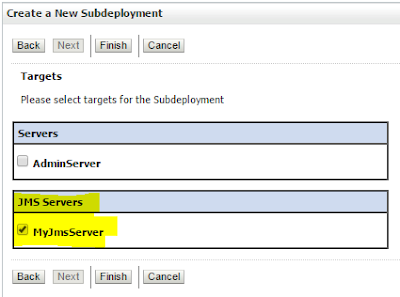Como cambiar el valor de autocommit en los data sources de JBOSS EAP 6.4 con ejemplo práctico:
In this post i´m going to resolve a problem with the jboss datasources, when you open a connection and get it throught a jboss datasource the autocommit mode is setted to true by default.
When you develop a new application where you can control all your code it is not a problem, but when you have inherited code that you cant change it, for example in a migration from a weblogic to a jboss server it could be a real problem
In my case I had java code inherited from weblogic and in some place of the code i was suffering problems with the autocommit state of my jdbc connection. I could not do commit or rollback becasuse the autocommit was setted to true, and it throw the next exception
java.slq.SQLException: you cannot rollback with autocommit set!
This is because in
weblogic 10.3 the jdbc connections have a extrange behavior because if you try to do a rollback with autocommit = true it has no effect butit doesn´t thow an exception. When you migrate this code to Jboss is a real problem that you have to handle.
In order to find a solution I have debugged the inherited code to looking for the classes that has been used to get the datasource connection. I found that the datasource class is
WrapperDataSource
In my case the solution was to create a
Wrapper of the class
WrapperDataSource in order to add the code to
setAutoCommit(false) in the
getConnetion methods, in order to get the connection with autocommit setted to false by default, when the application instace a jdbc connection from
Jboss server.
To do this we need to create a java project with the sources and the compiled classes of the this jar:
ironjacamar-jdbc-1.0.31.Final-redhat-1.jar in order to modify and compile the
WrapperDataSource class. This is the class that Jboss uses to create a new JDBC connection.
You can find this sources in the nex link or in my
github repository in the lib folder.
https://maven.repository.redhat.com/techpreview/all/org/jboss/ironjacamar/ironjacamar-jdbc/1.0.31.Final-redhat-1/
Also we need some jars in order to compile the
WrapperDataSource class, the jars are those:
- ironjacamar-core-api-1.0.31.Final-redhat-1.jar
- ironjacamar-jdbc-1.0.31.Final-redhat-1.jar
- jboss-connector-api_1.6_spec-1.0.1.Final-redhat-3.jar
- jboss-logging-3.1.4.GA-redhat-2.jar
- jboss-transaction-api_1.1_spec-1.0.1.Final-redhat-3.jar
All jars are in the Jbos EAP 6.4 distribution or in
my github repository code too.
https://developers.redhat.com/products/eap/download/
Now in the java project with all the jars (added to the poject build path) and the source files we can make the modification that we need. We only need to create the package
org.jboss.jca.adapters.jdbc and copy the class
WrapperDataSource.java from the source files into it. If you need to modify more classes take it from the source code, copy in the project and modify it.

Next step is to look up the getConnection Methods and add the
setAutocommit(false), after the connection creation,
Be carefull because in this version exists two getConnection methods and i have to modify both.
In next step you have to compile this class and mix with the original classes and create the new jar with my changes. In order to do this i have create an
ant script (buidl.xml) into the ant folder which unzip the orginal, jar, compile the modified class and add to the new jar.
--
<?xml version="1.0"?>
<project name="WrapperDataSource" default="build" basedir=".">
<property file="build.properties"/>
<target name="clean" description="Deletes compiled and generated code">
<delete dir="${build.dir}" />
</target>
<target name="build" depends="clean" description="build Wrapper">
<mkdir dir="${build.dir}" />
<unzip src="${build.dir}/../lib/ironjacamar-jdbc-1.0.31.Final-redhat-1.jar" dest="${build.dir}"/>
<path id="lib.path.ref">
<fileset dir="${lib.path.ref}" includes="*.jar"/>
</path>
<javac srcdir="${source.dir}" destdir="${build.dir}" classpathref="lib.path.ref" target="1.6"
source="1.6" debug="true"/> <jar destfile="${jar.dir}/${jar.name}"
basedir="${build.dir}"
/>
</target></project>
--
To
build the JAR with the new modified class, be sure to have
Apache Ant installed, go to
ant directory and execute the
"ant" command.
The result shoud be:
The result is in the
target/dist foder where you can find the new
MyJbossWrapperDataSource.jar
Finally the last step consists in change the original
ironjacamar-jdbc-1.0.31.Final-redhat-1.jar by the new
MyJbossWrapperDataSource.jar modifiying the
Jboss libray module.
To do this action you have to go to your JBOSS EAP6 installation and locate the next path:
[JBOSS_HOME]\modules\system\layers\base\org\jboss\ironjacamar\jdbcadapters\main\
Copy the new
MyJbossWrapperDataSource.jar to this location
and modify the
module.xml commenting the old jar file and adding the new
MyJbossWrapperDataSource.jar
--
<module xmlns="urn:jboss:module:1.1" name="org.jboss.ironjacamar.jdbcadapters">
<properties>
<property name="jboss.api" value="private"/>
</properties>
<resources>
<!--resource-root path="ironjacamar-jdbc-1.0.31.Final-redhat-1.jar"/>-->
<resource-root path="MyJbossWrapperDataSource.jar"/>
<!-- Insert resources here -->
</resources>
<dependencies>
<module name="javax.api"/>
<module name="javax.resource.api"/>
<module name="javax.validation.api"/>
<module name="org.hibernate.validator"/>
<module name="org.jboss.as.naming"/>
<module name="org.jboss.as.transactions"/>
<module name="org.jboss.common-core"/>
<module name="org.jboss.jboss-transaction-spi"/>
<module name="org.jboss.ironjacamar.api"/>
<module name="org.jboss.logging"/>
<module name="org.jboss.threads"/>
<module name="javax.xml.stream.api"/>
</dependencies>
</module>
--
You can download my eclipse project from github in the next link, if you want to get the code with this change appied, or make more changes in your jboss datasource.
https://github.com/antuansoft/MyJbossWrapperDataSource
Happy Wrapping!!!


































